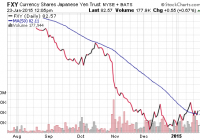Spike In eBay Shares On Q4 Earnings Puts These ETFs In Focus
The e-commerce giant eBay Inc (NASDAQ: EBAY ) came out with Q4 results after the closing bell on January 21. Overall, the mood was optimistic on an earnings beat and restructuring initiatives, though a sales-miss restrained investors from full-hearted optimism on the stock. Net income in the fourth quarter rose to $0.81 from $0.66 per share a year earlier, based on Zacks data. This beat the Zacks Consensus Estimate of $0.77, which excludes stock options and non-recurring expenses. Net revenues of $4.92 billion fell shy of the estimate of $4.97 billion but grew 9% year over year. Revenues were primarily volume driven. eBay’s Marketplaces segment generating revenues from the sale of goods available on eBay properties, recorded a 1% jump in net transaction revenues. However, as expected, pricing was an issue for the company which is why on the margin front, the e-commerce giant clearly underperformed. The non-GAAP operating margin was down 150 bps to 29.2% in the quarter. Restructuring procedure is on with the e-commerce player. eBay’s plan to spin off the PayPal business will be completed in the second half of 2015 and the online marketplace announced that it would lay off 7% of its workforce in the first quarter. The company also announced it has entered into a standstill agreement with Carl Icahn, who is the company’s largest activist shareholder . Weak Guidance Though the story was decent so far, the guidance took a beating. The company expects net revenues in the range of $4.35-$4.45 billion, failing the analysts’ projection of $4.71 billion, per Bloomberg . The company’s non-GAAP earnings per share are guided in the range of $0.68-$0.71. The company expects net revenues of $18.60-$19.1 billion for the full year and non-GAAP earnings per diluted share of $3.05-$3.15. Market Impact The company’s streamlining initiatives might have given its stock a boost post earnings. The stock gained 3.5% after hours on January 21. The results have put some ETFs with considerable exposure to eBay in focus. These funds are highlighted below: PowerShares Nasdaq Internet Portfolio (NASDAQ: PNQI ) This fund follows the Nasdaq Internet Index, giving investors exposure to the broad Internet industry. The fund holds about 94 stocks in its basket with AUM of $248 million while charging 60 bps in fees per year. The in-focus eBay occupies the second position with an 8.37% allocation. In terms of industrial exposure, Internet software and services make up for more than two-thirds of the basket, followed by Internet retail. PNQI has lost nearly 2.2% so far this year (as of January 21, 2015). First Trust Dow Jones Internet Index (NYSEARCA: FDN ) This is one of the most popular and liquid ETFs in the broad tech space with AUM of over $1.96 billion and average daily volume of more than 250,000 shares. The fund tracks the Dow Jones Internet Index and charges 57 bps in fees per year. In total, the fund holds 41 stocks in its basket with the in-focus eBay taking the third spot with a 5.53% share. From a sector look, information technology accounts for about 70% of the portfolio while consumer discretionary makes up 22%. The ETF is down about 2.9% year to date. Market Vectors Wide Moat ETF (NYSEARCA: MOAT ) This ETF follows the Morningstar Wide Moat Focus Index and provides equal-weighted exposure to 21 U.S. securities that have a unique sustainable competitive advantage in their respective industries. Here, eBay occupies the tenth position in the basket, accounting for 5% of total assets. The product is pretty spread out across various sectors with energy, information technology and consumer discretionary taking double-digit allocation. The fund has accumulated $898 million in its asset base and sees good volume of about 200,000 shares a day. Its expense ratio comes in at 0.49%. The fund has added nearly 5% so far this year. Bottom Line eBay currently carries a Zacks Rank #4 (Sell) with poor fundamentals. However, investors should note that Internet commerce segment – the industry eBay operates in – presently resides in the top 23% allocation of Zacks Industry Rank. The company itself is also striving hard to turn around by adopting every possible measure. All these point to a moderately bullish long-term outlook. So, investors counting on the long-term potential in the space can consider the recent rally in eBay shares as a start to the wining trend. However, an ETF approach may be better; at least it can cover up eBay’s short-term weakness with some other components’ strength.
